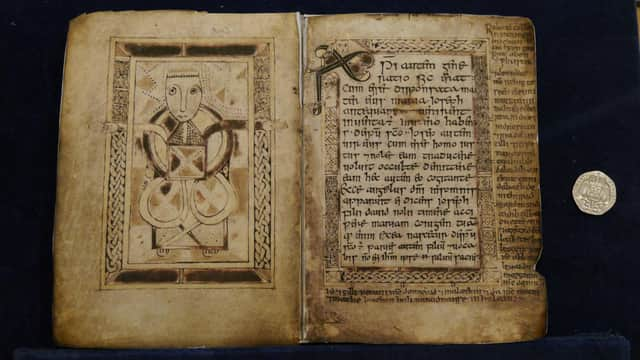Pictish-era book that features earliest example of written Gaelic to come home


The Book of Deer, which once belonged to a long-vanished monastery at Old Deer in Aberdeenshire, will return to the North East after a deal was struck with Cambridge University, where it has been held for more than 300 years.
The pocket-sized book of gospels, which was written in Latin on vellum sometime between the 8th and 10th Century, later had Scottish Gaelic notes on local land transactions added into its margins.
Advertisement
Hide AdAdvertisement
Hide AdSome have compared it to the Book of Kells, the richly decorated collection of gospels that is considered one of Ireland’s greatest cultural treasures.
The Book of Deer Project has successfully negotiated a loan of the book from Cambridge University after many years of talks.
Derek Jennings, vice chairman of The Book of Deer Project, said: “These are exciting times for us. The Book of Deer is one of Scotland’s most iconic items which has the oldest examples of Scottish Gaelic written on its pages.
“We have had discussions with Cambridge University and they have now agreed that it can go on loan. The discussion now is where we can display it given security will be the most important issue.”
Mr Jennings said the Sir Duncan Rice Library at Aberdeen University was being discussed as a possible venue to display the book, which will go on show in 2022.However, he added that the project team would ideally like it to be displayed in Old Deer itself, given its links to the lost monastery, which was built around the 6th Century.
Mr Jennings said: “Absolutely, we would like it to come to Old Deer. It is said the book was taken by Edward I down to England because of the sway that it held over local people. They have always considered the book to be an important item.”
Some believe the Book of Deer was actually produced by monks at the monastery which was associated with St Columba and his disciple Drostan.In the 12th Century, the Monks of Deer used the blank spaces and the margins to add the Gaelic notes with the entries the earliest continuous examples of written Scots Gaelic.
Dr Michelle MacLeod, senior lecturer in Gaelic at the University of Aberdeen, earlier said: “The Book of Deer is a tiny book but it has left a huge legacy for us, not only in the north-east but for the whole of Scotland. We had to wait another 200-300 years after the Book of Deer to find any more evidence of written Scottish Gaelic.”
Advertisement
Hide AdAdvertisement
Hide AdThe Book of Deer Project has worked with archaeologists over the past 10 years to try and find the location of the lost monastery.
As preparations are made to return the book to the North East on a temporary basis, archaeologists are due to embark on a further, major dig in a bid to finally locate the old religious centre.
Last year, the focus of the search switched to land near 12th Century Deer Abbey and found evidence of a much older building beneath the site.
Archaeologists, led by Ali Cameron of Cameron Archaeology, plan to return to investigate further with a Crowdfunder campaign now underway to raise £40,000 to finance the excavation and cover the costs associated with displaying the book in Scotland.“Air Tòir Manachainn Dhèir (The Lost Monastery of Deer)” will screen on BBC ALBA on Wednesday 9th Sept at 9pm.
A message from the Editor:Thank you for reading this story on our website. While I have your attention, I also have an important request to make of you.With the coronavirus lockdown having a major impact on many of our advertisers - and consequently the revenue we receive - we are more reliant than ever on you taking out a digital subscription.Subscribe to scotsman.com and enjoy unlimited access to Scottish news and information online and on our app. With a digital subscription, you can read more than 5 articles, see fewer ads, enjoy faster load times, and get access to exclusive newsletters and content. Visit https://www.scotsman.com/subscriptions now to sign up.
Our journalism costs money and we rely on advertising, print and digital revenues to help to support them. By supporting us, we are able to support you in providing trusted, fact-checked content for this website.
Joy Yates
Editorial Director